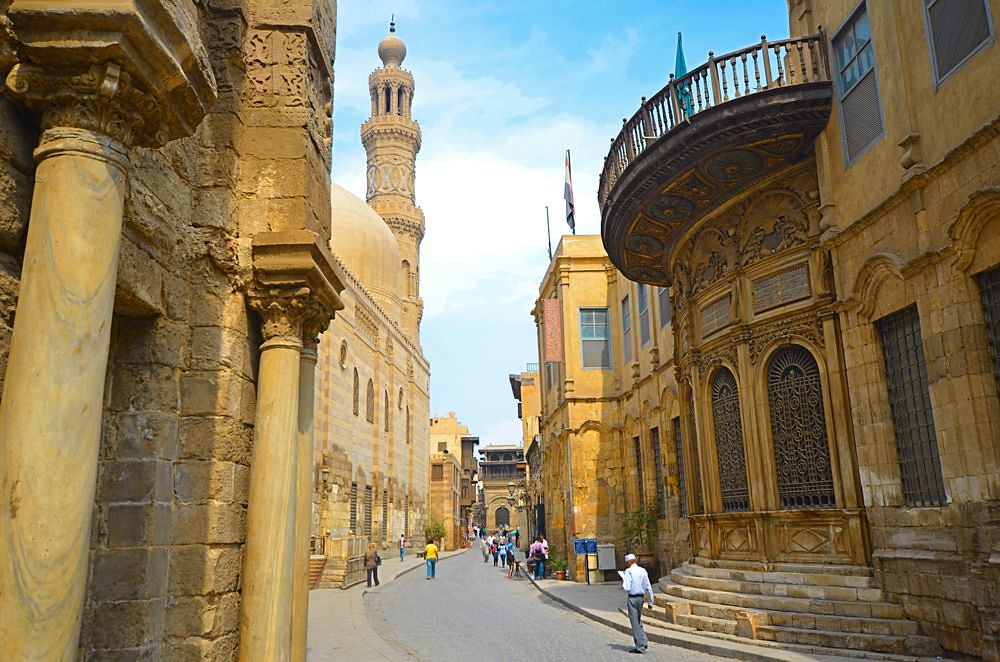
Introduction: Old Cairo
Old Cairo Nestled along the banks of the timeless Nile River, Old Cairo stands as a living testament to millennia of human history. This ancient district, also known as Coptic Cairo, is a treasure trove of cultural richness and historical significance. Its cobblestone streets and age-old structures whisper tales of empires, religions, and civilizations that have left an indelible mark on this vibrant city.
In this journey through time, we will unveil the top seven historical landmarks that grace the heart of Old Cairo. Each of these architectural marvels and sacred sites offers a window into a bygone era, inviting us to walk in the footsteps of those who shaped the destiny of this extraordinary city.

Join us as we embark on a captivating exploration of Old Cairo’s most cherished heritage sites, where the past intertwines seamlessly with the present and where the echoes of history resonate through every stone and archway. From ancient churches to resplendent mosques, from synagogues to citadels, this is a voyage that promises to illuminate not only the history of Cairo but also the essence of human civilization itself.
1. The Hanging Church (Saint Virgin Mary’s Coptic Orthodox Church)
History and Architecture

Detailed history of the Hanging Church:
The Hanging Church, officially known as Saint Virgin Mary’s Coptic Orthodox Church, is an architectural marvel that traces its roots back to the 3rd century AD. Its name, “Hanging Church,” derives from its location above the gatehouse of the Roman fortress of Babylon. This sacred site has witnessed centuries of religious devotion, surviving conquests, and renovations that stand as a testament to Egypt’s enduring Christian heritage.
Architectural Features:
The church’s design is a blend of Coptic, Roman, and Byzantine influences. Its wooden roof, supported by 13 graceful columns, reflects an intricacy that belies its age. The beautiful iconoclasts, adorned with mesmerizing icons, divide the nave from the sanctuary, embodying the spiritual journey of the Coptic Orthodox faith.
Significance in Coptic Christian history and religion
The Hanging Church holds a paramount position in Coptic Christian history. It served as the residence of the Coptic Pope for over three centuries and witnessed pivotal moments in the development of Coptic Orthodox doctrine. Its consecration, dedicated to the Virgin Mary, underscores her revered status within the faith.

This sacred space has been a beacon of spiritual solace for Coptic Christians, providing a sanctuary for prayer, reflection, and communal worship. It stands as a living testament to the resilience and endurance of the Coptic Orthodox Church in the face of challenges and adversity.
Cultural Significance
Influence on Coptic Christian traditions and practices:
The Hanging Church has played a pivotal role in shaping the religious practices and traditions of Coptic Christians. It is a repository of liturgical rites, hymns, and sacraments that have been passed down through generations. Pilgrims from all corners of the world flock to this revered site to partake in these ancient rituals, forging a spiritual connection that transcends time and space.
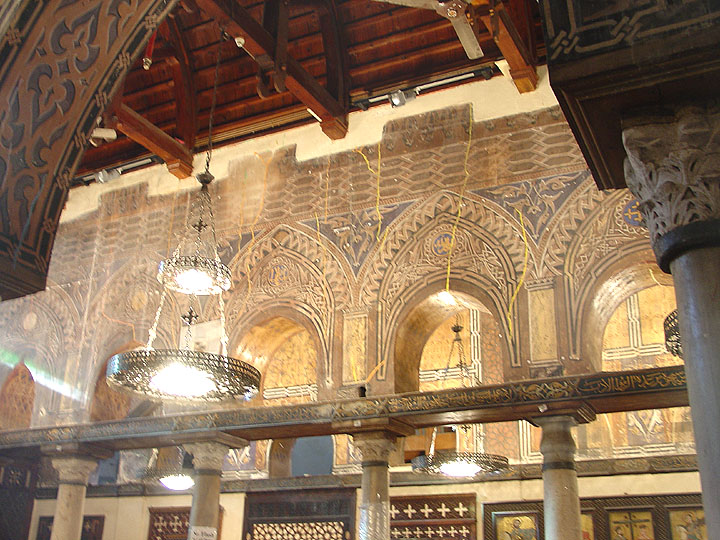
Visitor experience and religious events:
Stepping into the hallowed halls of the Hanging Church is a profoundly moving experience. The air is imbued with an aura of devotion, and the walls echo with centuries-old prayers. Visitors are met with awe-inspiring frescoes and icons that narrate biblical tales and depict saints and martyrs. The church also hosts various religious events, from solemn liturgical ceremonies to joyous festivals, providing a vivid tapestry of the Coptic Christian faith.
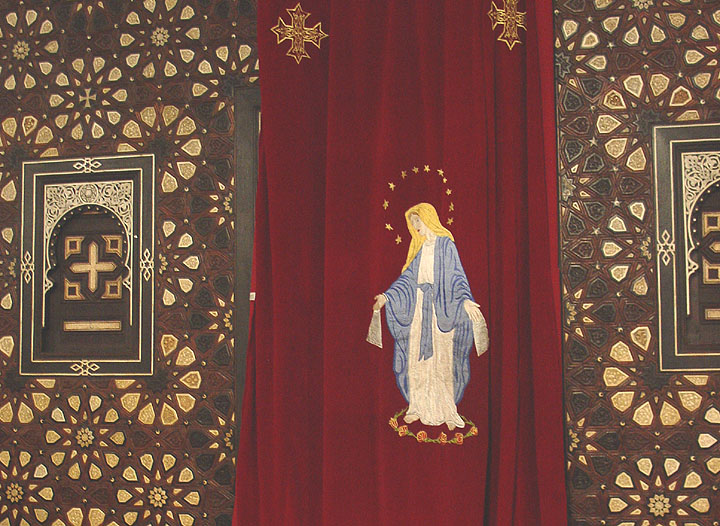
As the sun filters through stained-glass windows, casting vibrant hues upon the ancient stones, one cannot help but be transported to a realm where the spiritual and the earthly converge—a testament to the enduring legacy of the Hanging Church in the hearts of believers and the annals of history.
2. Ibn Tulun Mosque
Islamic Architecture and History

Unique Architectural Features:
The Ibn Tulun Mosque stands as a crowning achievement of Islamic architecture, renowned for its distinctive design elements. Its grandeur lies in its simplicity, with an expansive courtyard and a central sanctuary distinguished by soaring walls and graceful arches. Notably, the spiral minaret, a hallmark of the mosque, stands as a testament to the architectural innovation of the era.
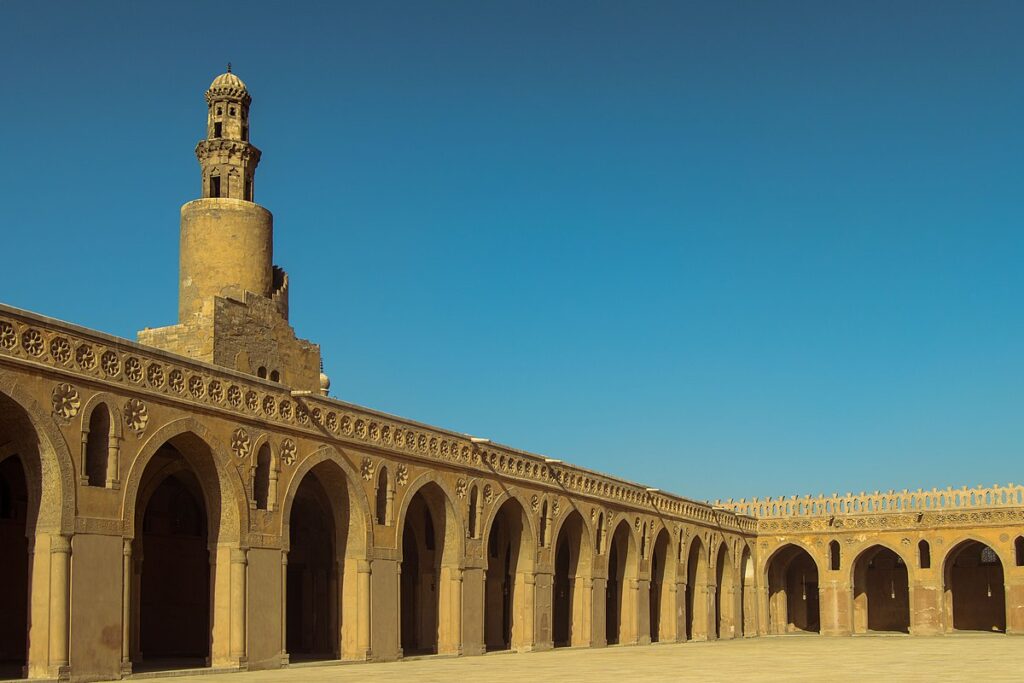
Constructed entirely of carved red bricks, the mosque’s minaret is a marvel of engineering, and its spiral ascent is an elegant tribute to Islamic craftsmanship. The ablution fountain, adorned with geometric patterns, showcases the meticulous attention to detail that defines the mosque’s design.
Historical Context and the Rule of Ahmad bin Tulun:
Commissioned by Ahmad bin Tulun, an enterprising governor of Egypt in the 9th century, this mosque became an enduring symbol of his legacy. During Ibn Tulun’s rule, which spanned from 868 to 884 AD, Egypt experienced a period of relative stability and cultural flourishing. The mosque served not only as a place of worship but also as a center for intellectual exchange and communal gatherings.
Islamic Art and Culture
Influence on Islamic Art and Architectural Styles:
The Ibn Tulun Mosque left an indelible mark on Islamic art and architecture. Its minimalist yet imposing design, characterized by the absence of decorative elements, served as a precursor to the architectural styles that would later define Islamic aesthetics. The use of red bricks, a departure from the prevalent stone-based architecture of the time, demonstrated an innovative approach to construction that influenced subsequent Islamic structures.
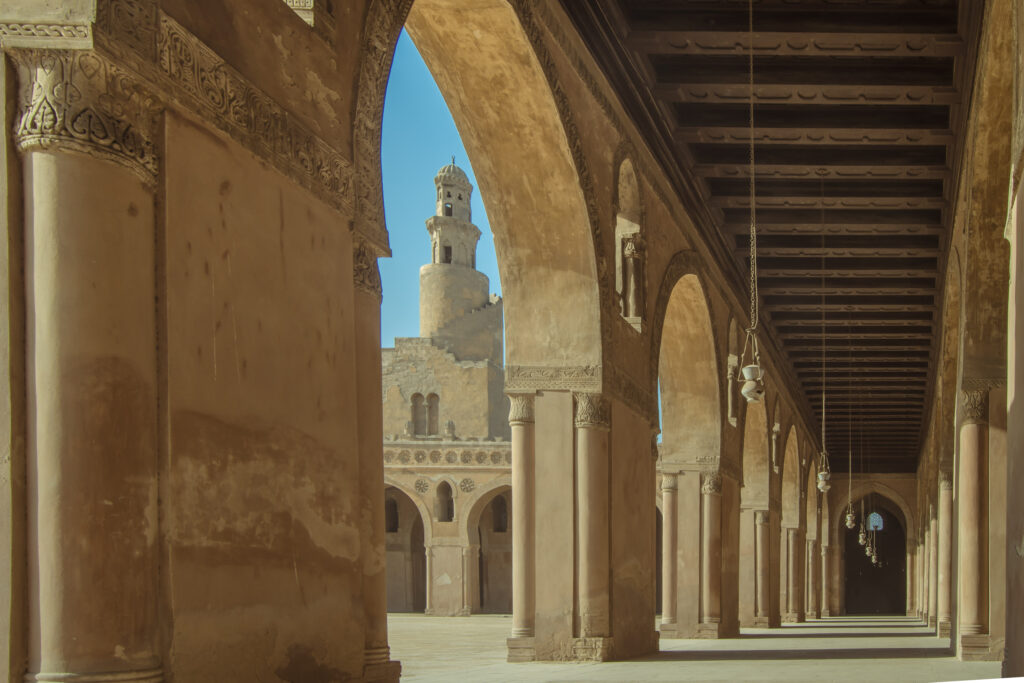
The mosque’s influence resonated beyond Egypt, inspiring architects and artisans across the Islamic world. Elements of its design can be observed in mosques and architectural marvels throughout the Middle East and North Africa, showcasing the enduring legacy of Ibn Tulun’s vision.
Role in the Cultural Landscape of Old Cairo:
The Ibn Tulun Mosque stands as a sentinel, bearing witness to the ebb and flow of centuries. Amidst the bustling streets of Old Cairo, it remains a bastion of cultural and spiritual significance. Beyond its architectural splendor, the mosque continues to serve as a living testament to the cultural diversity and artistic ingenuity that define the Islamic world.
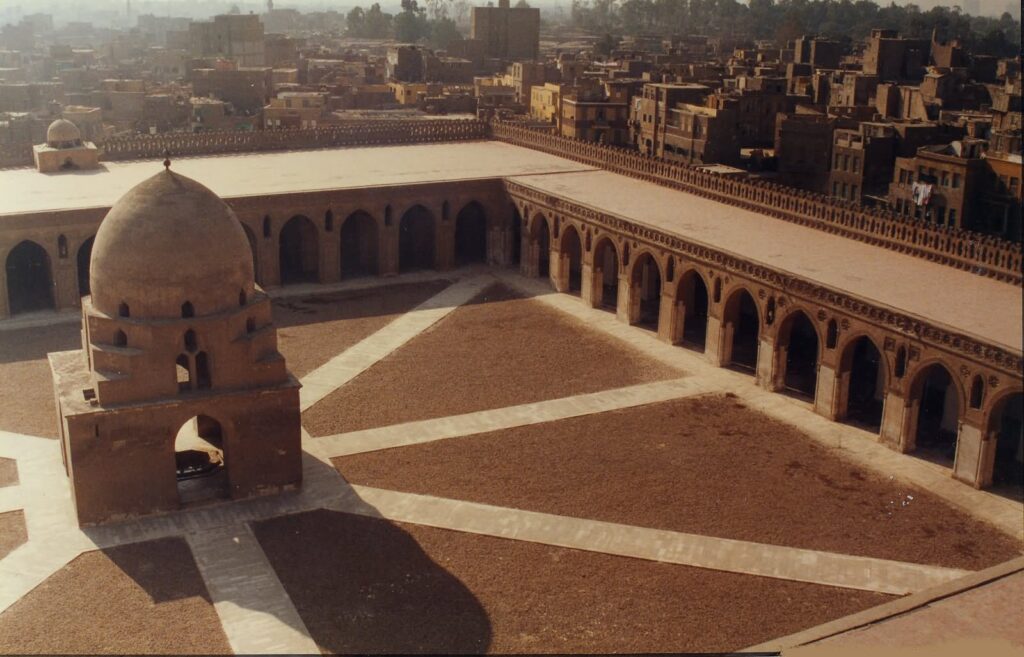
Its tranquil courtyard and prayer halls provide a sanctuary for worshipers and visitors alike, offering a respite from the urban dynamism that surrounds it. As the call to prayer echoes through its halls, the mosque’s enduring presence reminds us of the profound cultural heritage that is interwoven with the fabric of Old Cairo.
3. The Coptic Museum
Collection Highlights

Overview of the Museum’s Exhibits and Their Historical Significance:
The Coptic Museum, nestled in the heart of Old Cairo, stands as a repository of Egypt’s rich Coptic Christian heritage. Its halls house a diverse collection of artifacts spanning centuries, providing a vivid tableau of the evolution of Coptic culture, art, and religion. The exhibits range from intricately woven textiles and illuminated manuscripts to ornate woodwork and ancient icons, each offering a window into the spiritual and artistic expressions of the Coptic community.
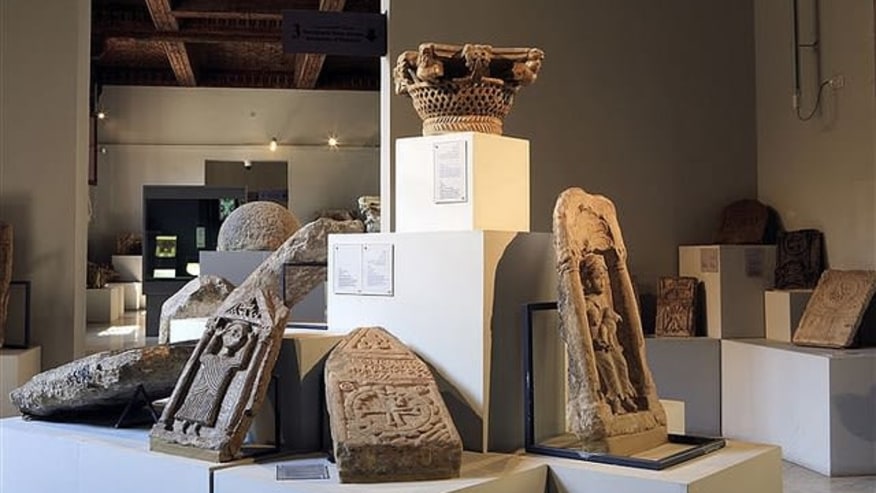
Among the notable highlights are rare fragments of early Christian frescoes, offering a glimpse into the sacred spaces of ancient Coptic churches. These fragments, painstakingly preserved and delicately restored, bear witness to the early roots of Christianity in Egypt and the ingenuity of Coptic artisans.
Notable Artifacts and Their Stories:
One of the museum’s prized possessions is the “Sword of Saint Menas,” a relic believed to be associated with the revered Coptic martyr. Its intricate engravings and historical significance serve as a testament to the enduring veneration of Saint Menas within the Coptic Christian tradition.
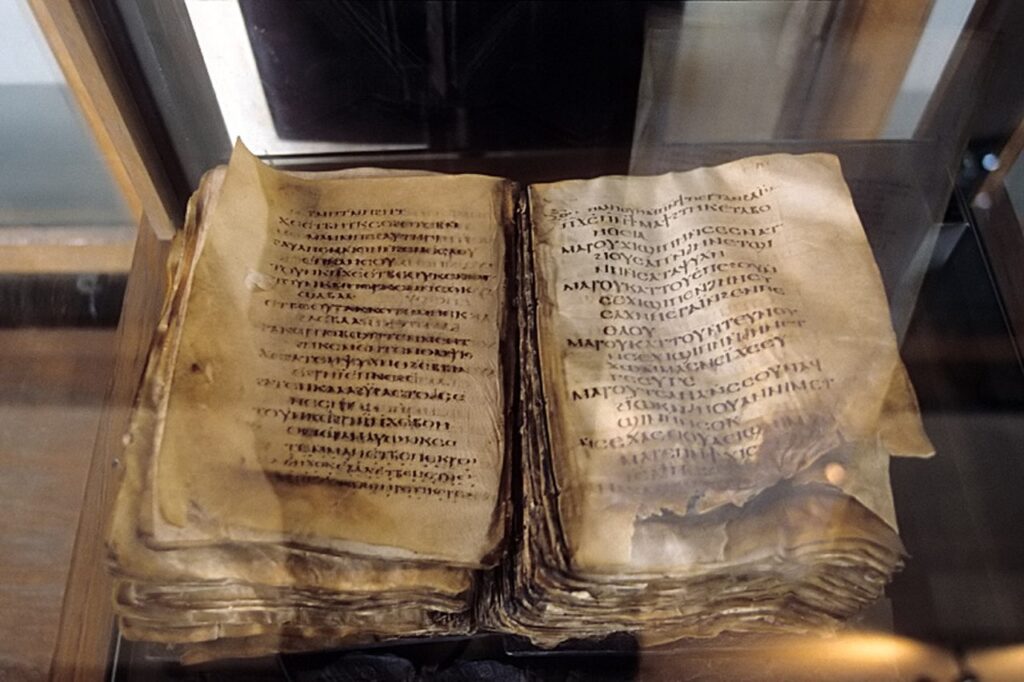
Another remarkable artifact is the “Nubian Triptych,” a beautifully crafted wooden altarpiece that provides insight into the artistic exchanges between Nubian and Coptic cultures. Its detailed carvings and vibrant pigments speak to the cross-cultural influences that shaped the religious art of the region.
Preservation Efforts
Role of the Coptic Museum in Preserving Coptic Heritage:
The Coptic Museum stands as a guardian of Egypt’s Coptic heritage, dedicated to the conservation and promotion of this invaluable cultural legacy. Through meticulous curation and state-of-the-art preservation techniques, the museum safeguards a myriad of artifacts from the erosive forces of time and environment.
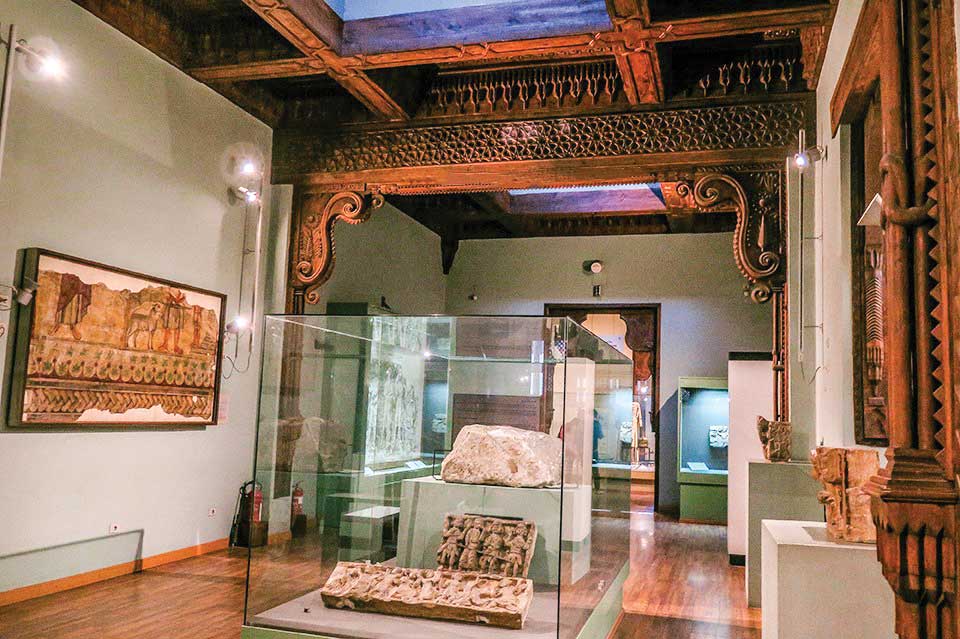
In addition to its role as a repository, the museum serves as an educational hub, enlightening visitors about the historical and religious significance of Coptic Christianity in Egypt. Its exhibits offer a tangible link to the past, fostering a deeper understanding of the enduring traditions and contributions of the Coptic community.
Collaborations and Initiatives for Conservation:
The Coptic Museum collaborates with a network of international institutions, conservationists, and experts to enhance its preservation efforts. Through joint ventures and knowledge-sharing initiatives, the museum benefits from cutting-edge conservation practices and gains access to a global community dedicated to safeguarding cultural heritage.

Furthermore, the museum engages in outreach programs and workshops, training the next generation of conservators and fostering a culture of conservation awareness within the local community. These initiatives ensure that the legacy of Coptic Christian heritage endures for generations to come, serving as a source of inspiration and cultural pride.
4. Saladin Citadel of Cairo
Citadel History

Historical Background of the Saladin Citadel and Its Purpose:
Perched majestically atop the Mokattam Hills, the Saladin Citadel of Cairo, often referred to simply as the Cairo Citadel, is a testament to both military prowess and architectural grandeur. It owes its existence to the legendary Salah ad-Din Yusuf ibn Ayyub, commonly known as Saladin, the celebrated Muslim general and statesman who recaptured Jerusalem from the Crusaders.
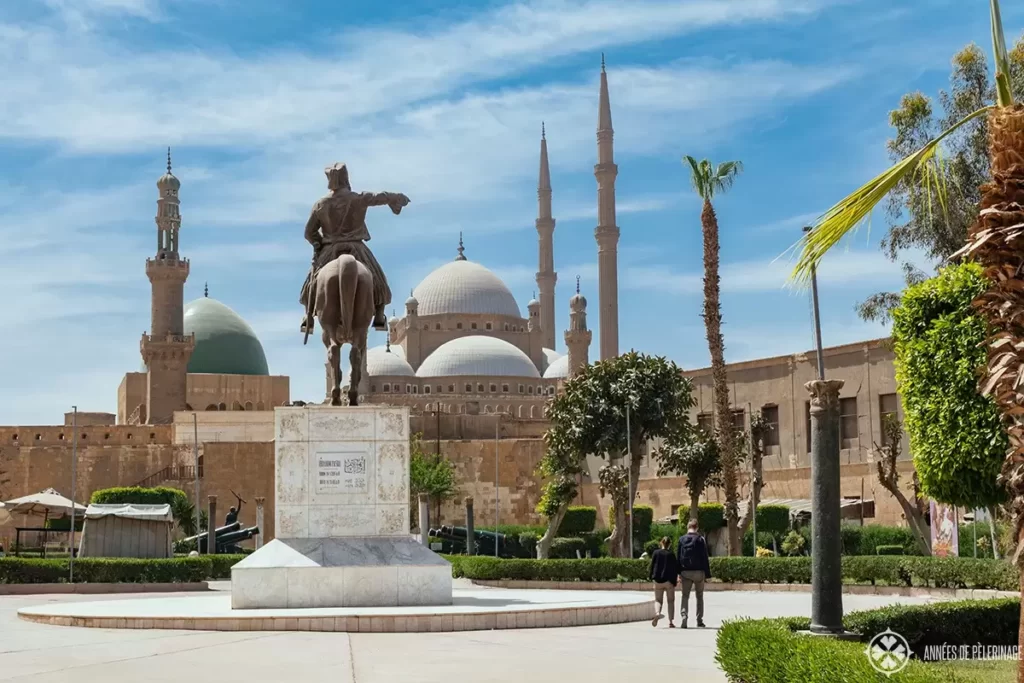
Constructed in the 12th century (between 1176 and 1183), the Citadel was envisioned as a fortified stronghold that would serve as a defensive bastion against potential invasions. It also held symbolic significance, representing the consolidation of Saladin’s rule and the unification of Egypt and Syria under the Ayyubid dynasty.
Influence on the City’s Defense and Governance:
The citadel’s strategic location provided an unparalleled vantage point, affording its defenders an unobstructed view of the surrounding terrain and the city of Cairo below. This elevated position endowed the citadel with a formidable advantage in terms of defense, rendering it an impregnable fortress against external threats.
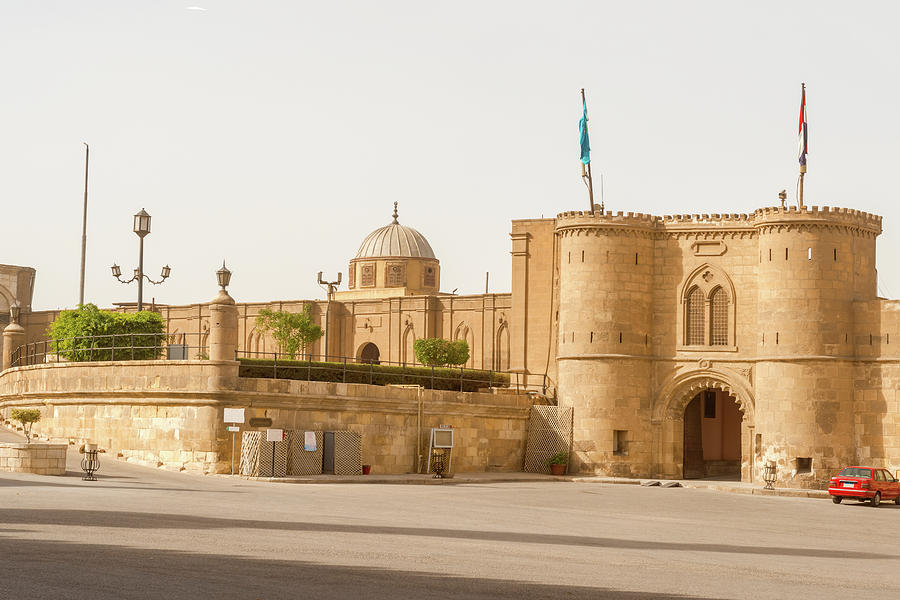
Beyond its military significance, the Citadel also played a pivotal role in governance. It served as the seat of power for numerous rulers and dynasties that followed Saladin, including the Mamluks and Ottomans. The decisions made within its walls reverberated through the annals of Egyptian history, shaping the destiny of the region for centuries.
Architectural Marvels
Description of Key Structures Within the Citadel:
Within the expansive grounds of the Saladin Citadel, several key structures stand as architectural marvels in their own right. The most prominent among them is the Mosque of Muhammad Ali, also known as the Alabaster Mosque. This Ottoman-era masterpiece, completed in the 19th century, exudes grandeur with its imposing domes and elegant minarets.

Additionally, the Citadel houses the National Military Museum, a repository of Egypt’s military history, showcasing artifacts and exhibits spanning millennia.
Notable Features and Their Architectural Significance:
The Mosque of Muhammad Ali, with its commanding central dome and intricate Ottoman design, melds elements of classical Islamic architecture with distinctive Ottoman aesthetics. Its sprawling courtyard and meticulously crafted interior exemplify the architectural opulence of the period.

The walls and bastions of the citadel, constructed primarily from limestone and granite, bear witness to the skilled craftsmanship of the era. The fortifications, including the iconic Qaitbay Bastion, were ingeniously designed to withstand the test of time and remain a testament to the engineering prowess of the architects.
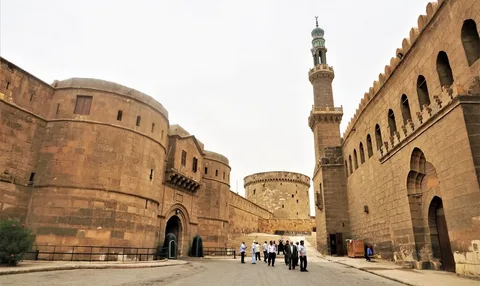
As visitors traverse the citadel’s labyrinthine passageways and gaze upon its formidable walls, they are transported to an era where military might and architectural splendor converged, leaving an indelible mark on Cairo’s skyline and the annals of history. The Saladin Citadel, with its rich historical tapestry and awe-inspiring architecture, stands as a living testament to the enduring legacy of a bygone age.
5. The Sultan Hassan Mosque and Madrasa
Mamluk Architecture and Education

Architectural elements unique to the Sultan Hassan Mosque:
The Sultan Hassan Mosque and Madrasa, an architectural gem nestled within the heart of historic Cairo, stands as a testament to the ingenuity of Mamluk architecture. Its towering minaret, soaring over the bustling streets, commands attention with its intricate geometric patterns and elegant arabesque details. The mosque’s expansive courtyard, flanked by imposing facades, creates a sense of awe and reverence.
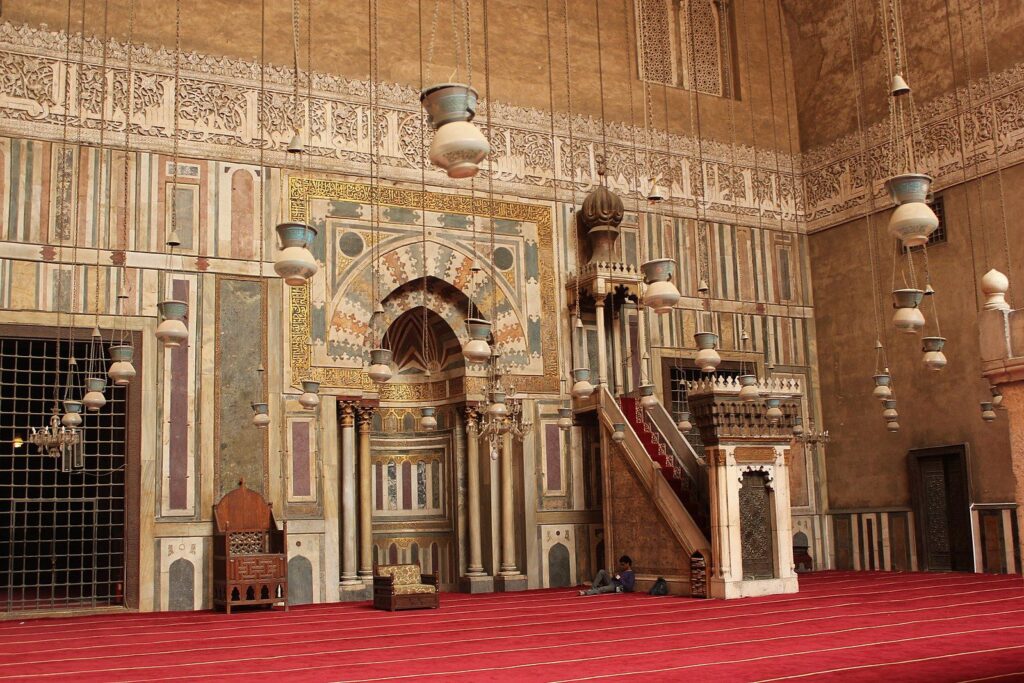
One of the most distinctive features is the monumental prayer hall, a soaring space supported by massive stone columns. This architectural marvel not only serves its utilitarian purpose but also encapsulates the grandeur and sophistication of Mamluk design.
Historical Context of Islamic Education during the Mamluk Era:
During the Mamluk era (1250–1517), Cairo emerged as a vibrant center of intellectual and educational pursuits. The Sultan Hassan Mosque and Madrasa was conceived not only as a place of worship but also as an educational institution, exemplifying the Mamluk commitment to scholarship.
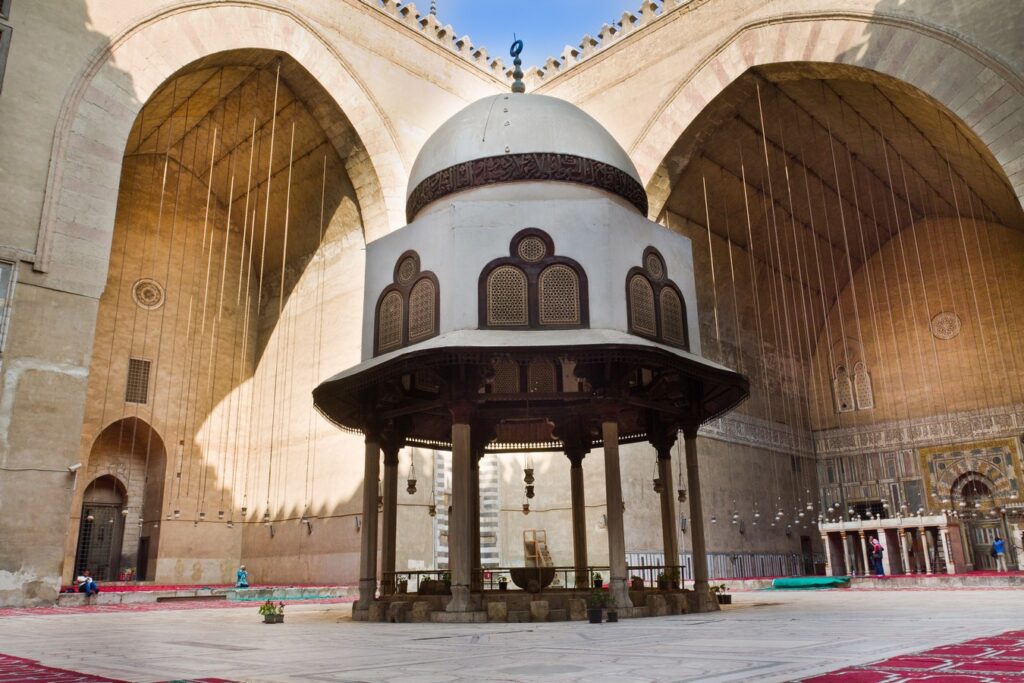
The Madrasa, an integral component of the complex, provided a comprehensive curriculum that encompassed Islamic law, theology, grammar, rhetoric, and the sciences. Students flocked to this prestigious institution from across the Islamic world, drawn by the reputation of its esteemed scholars and the allure of Cairo’s intellectual milieu.
Artistic Details
Decorative Elements and Their Symbolism:
The Sultan Hassan Mosque and Madrasa are adorned with an array of decorative elements that bear profound symbolism. Intricate geometric patterns, interwoven with arabesques, adorn the walls, arches, and domes, reflecting the mathematical precision and aesthetic harmony prized in Islamic art. Floral motifs, reminiscent of paradise gardens, evoke spiritual transcendence and earthly beauty.
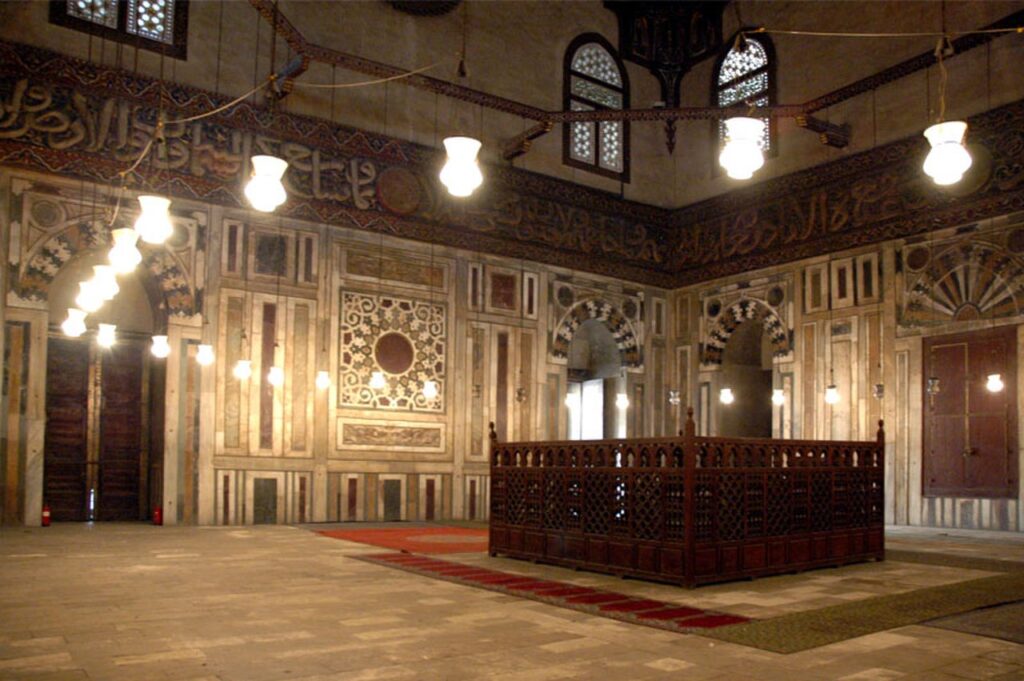
The use of calligraphy, in exquisite Quranic inscriptions and poetic verses, serves not only as a visual adornment but also as a means of imparting spiritual messages to the faithful. The lavish use of marble, with its luminescent beauty, exemplifies the Mamluk appreciation for opulence and elegance.
Integration of Religious Teachings in the Architecture:
Every facet of the Sultan Hassan Mosque and Madrasa’s architecture is imbued with religious significance. The meticulous alignment of architectural elements and the careful consideration of proportions were intended to create an environment conducive to spiritual contemplation and worship.
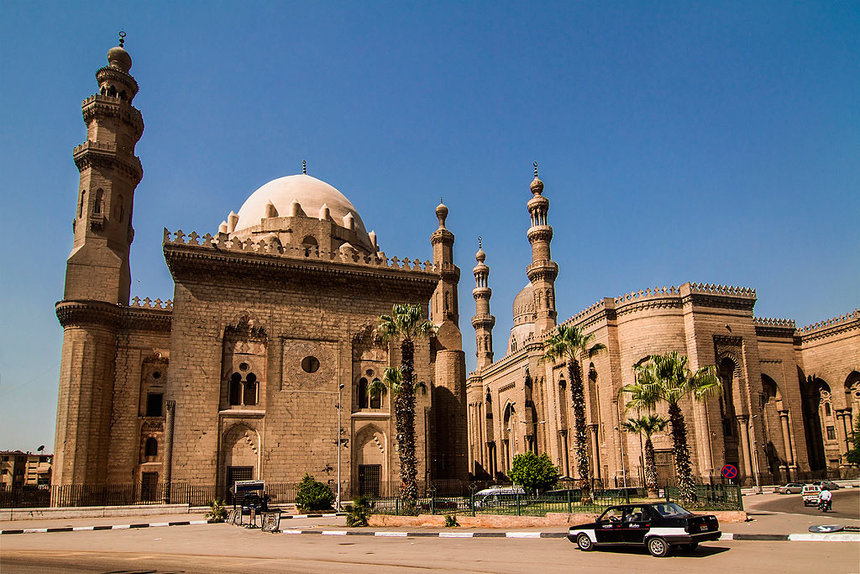
The mihrab, an ornate niche indicating the direction of Mecca, stands as the focal point of the prayer hall, emphasizing the centrality of the Qibla in Islamic devotion. The minbar, an elevated pulpit, serves as a platform for the delivery of sermons, reinforcing the role of the mosque as a space for religious instruction and guidance.
As one stands within the hallowed halls of the Sultan Hassan Mosque and Madrasa, the marriage of architectural splendor and religious devotion becomes palpable. Each intricacy, each motif, serves as a testament to the profound spiritual and intellectual legacy that endures within these walls, a living testament to the golden age of Mamluk Cairo.
6. The Church of St. Sergius and Bacchus
Christian Tradition and History

Significance of St. Sergius and Bacchus in Christian History:
The Church of St. Sergius and Bacchus, nestled in the heart of Old Cairo, holds profound significance in Christian history. This venerable sanctuary is dedicated to Saints Sergius and Bacchus revered Christian martyrs who became emblematic figures of unwavering faith in the face of persecution.
According to tradition, Sergius and Bacchus were Roman soldiers who, because of their steadfast Christian beliefs, faced martyrdom in the 4th century. Their legacy resonated across the Christian world, inspiring countless believers to stand firm in their faith.
Early Christian Communities in Egypt:
The establishment of the Church of St. Sergius and Bacchus is intertwined with the emergence of early Christian communities in Egypt. Egypt played a pivotal role in the spread and development of Christianity, and Old Cairo stood at the epicenter of this transformative era. The church’s foundations are believed to date back to the 4th century, making it one of the oldest Christian sites in Egypt.

Architectural Characteristics
Notable Architectural Features of the Church:
The Church of St. Sergius and Bacchus exudes an aura of antiquity and spiritual sanctity. Its architectural style seamlessly blends ancient Roman influences with Coptic Christian elements. The church’s nave, characterized by a basilical layout, features intricately carved marble screens that separate the sanctuary from the congregational space. The apse, adorned with luminous icons, serves as the focal point of religious devotion.
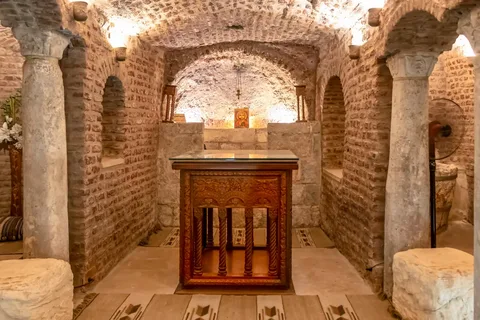
One of the most distinctive features is the crypt, believed to have cradled the Holy Family during their flight to Egypt. This sacred space, accessed by a descending staircase, serves as a poignant reminder of the pivotal role this church played in the early years of Christianity.
Preservation Efforts and Restoration Projects:
Over the centuries, the Church of St. Sergius and Bacchus has borne witness to the passage of time and the trials of history. Yet, dedicated preservation efforts have ensured its continued existence as a living testament to Christian heritage.
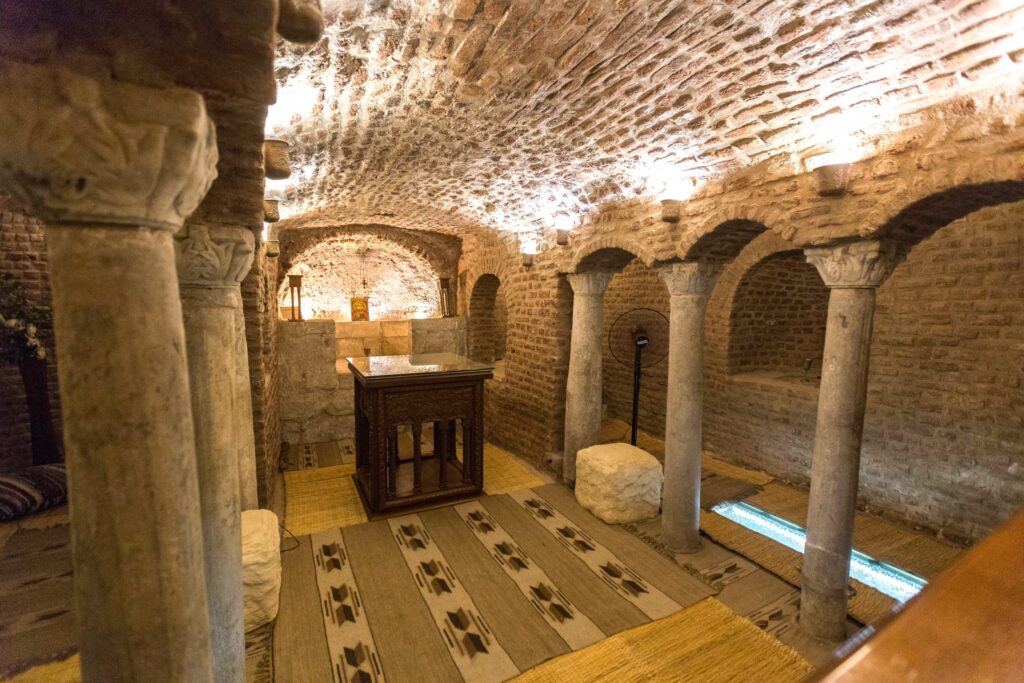
Restoration projects, undertaken by skilled artisans and conservationists, have breathed new life into the church, preserving its architectural integrity and safeguarding its priceless relics. These endeavors, often conducted in collaboration with international organizations, highlight the collective commitment to the conservation of this invaluable cultural treasure.
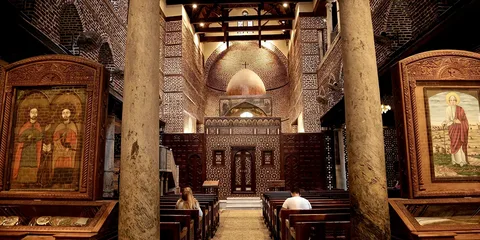
As visitors step through the hallowed threshold of the Church of St. Sergius and Bacchus, they are transported back in time, enveloped in the aura of early Christian devotion. The architectural splendor and historical significance of this sacred sanctuary serve as a beacon, illuminating the enduring legacy of the Christian faith in the heart of Old Cairo.
7. The Ben Ezra Synagogue
Jewish Heritage in Cairo

Historical Background of the Jewish Community in Cairo:
The Jewish community in Cairo boasts a heritage that spans millennia, dating back to ancient times. As one of the oldest Jewish communities in the world, Cairo’s Jewish population played a pivotal role in shaping the city’s cultural and economic landscape. Their presence can be traced to the Babylonian exile, with subsequent waves of immigration contributing to the rich tapestry of Jewish life in Cairo.
Over the centuries, Jewish quarters and synagogues became integral parts of the city’s social fabric. The community’s contributions extended beyond religious practice, encompassing various facets of Egyptian society, including commerce, art, and scholarship.
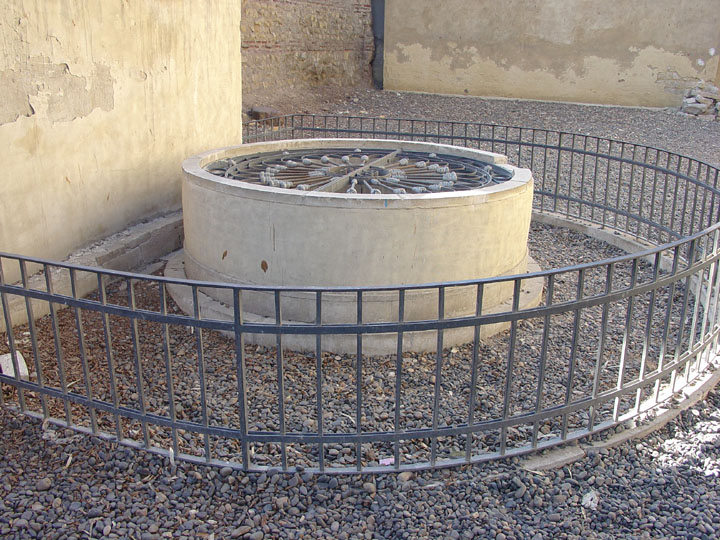
Significance of the Ben Ezra Synagogue:
Among the cherished landmarks that bear witness to Cairo’s Jewish heritage, the Ben Ezra Synagogue holds a place of utmost prominence. Its origins are steeped in legend and history, as it is believed to have been built on the site where the infant Moses was discovered among the reeds of the Nile. This sacred association endows the synagogue with profound spiritual significance.
The synagogue also played a crucial role in preserving a trove of Jewish texts, known as the Geniza documents, providing invaluable insights into the daily lives, beliefs, and practices of medieval Jewish communities.
Architectural Details
Unique Features of the Synagogue’s Design:
The Ben Ezra Synagogue exhibits a fusion of architectural styles that mirror the diverse influences that have shaped Cairo’s history. Its design combines elements of Islamic, Gothic, and Renaissance architecture, creating a distinctive aesthetic that captures the multicultural essence of the city.
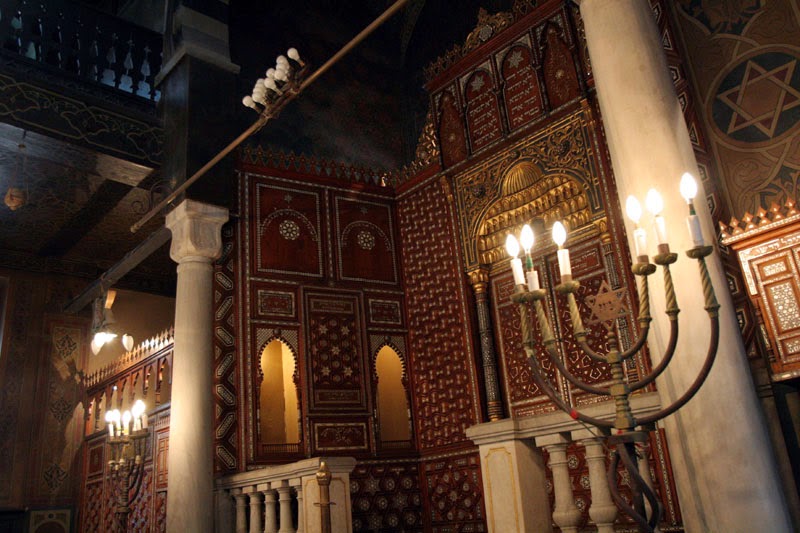
One of the most striking features is the intricately carved wooden Torah ark, which houses sacred scrolls of scripture. The pulpit, adorned with ornate decorations, serves as a focal point for religious ceremonies. The synagogue’s intimate layout and richly decorated interior create an atmosphere of reverence and contemplation.
Cultural Events and Activities at the Synagogue:
Beyond its architectural splendor, the Ben Ezra Synagogue remains a vibrant hub of cultural and religious activity. It hosts a variety of events and celebrations that bring together members of the Jewish community and visitors alike. From religious services and ceremonies to lectures and cultural festivals, the synagogue serves as a nucleus for the preservation and celebration of Jewish traditions.

Throughout the year, the synagogue’s halls echo with prayers, songs, and the vibrant voices of congregants, creating a living testament to the enduring strength and vitality of Cairo’s Jewish community.
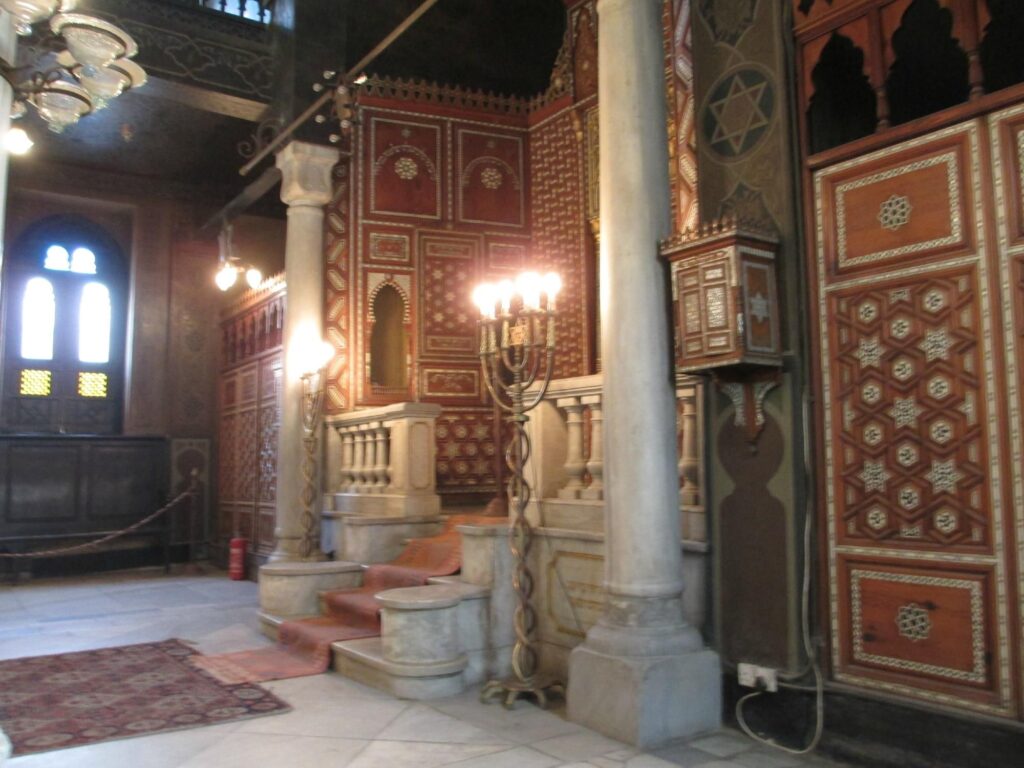
As visitors step into the hallowed precincts of the Ben Ezra Synagogue, they are met with a profound sense of history and reverence. This sacred space stands as a testament to the enduring legacy of Cairo’s Jewish community, a testament to their faith, heritage, and enduring contributions to the cultural mosaic of the city.
Conclusion
The historical landmarks of Old Cairo stand as living testaments to the rich tapestry of human history, weaving together the threads of diverse cultures, religions, and civilizations. Each site, from the Hanging Church to the Ben Ezra Synagogue, carries with it a profound significance that transcends time, offering a window into the collective heritage of humanity.
These sacred spaces and architectural marvels have weathered the centuries, bearing witness to triumphs, challenges, and the enduring spirit of those who built and worshipped within their hallowed walls. The Hanging Church, with its ancient stones, tells of the steadfastness of Coptic Christians. The Ibn Tulun Mosque echoes the voices of generations, carrying the legacy of Islamic artistry and devotion. The Coptic Museum safeguards the treasures of Coptic culture, while the Saladin Citadel stands as a sentinel, guarding the heart of Old Cairo.
The Sultan Hassan Mosque and Madrasa, with their soaring arches and intricate carvings, are monuments to the intellectual and artistic heights achieved during the Mamluk era. The Church of St. Sergius and Bacchus, nestled amidst the bustling streets, carries the echoes of early Christian communities. Finally, the Ben Ezra Synagogue, with its timeless elegance, embodies the enduring strength and resilience of Cairo’s Jewish heritage.
It is imperative that we, as stewards of this cultural legacy, take up the mantle of preservation and exploration. These landmarks are not merely relics of the past; they are living embodiments of the ideals, aspirations, and faiths of those who came before us. By exploring these sites, we step into the footprints of history, gaining insight into the vibrant tapestry of Old Cairo’s past.
So, I encourage you to embark on this journey through time. Visit these hallowed sites, let the stones speak to you, and allow the echoes of history to resonate within you. Delve into the fascinating history of Old Cairo, and in doing so, become a part of the ongoing narrative that breathes life into these timeless landmarks. In preserving and cherishing these sites, we ensure that their legacy endures for generations to come, inspiring awe and reverence in the hearts of all who are fortunate enough to experience their majesty.

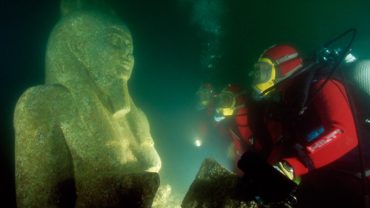
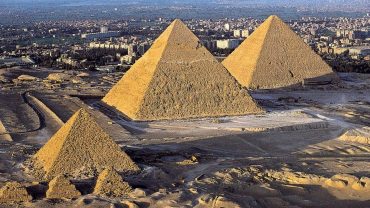
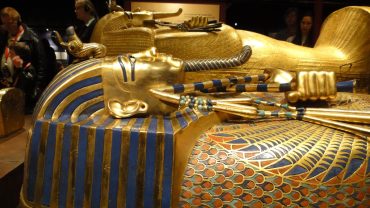

Comment (0)